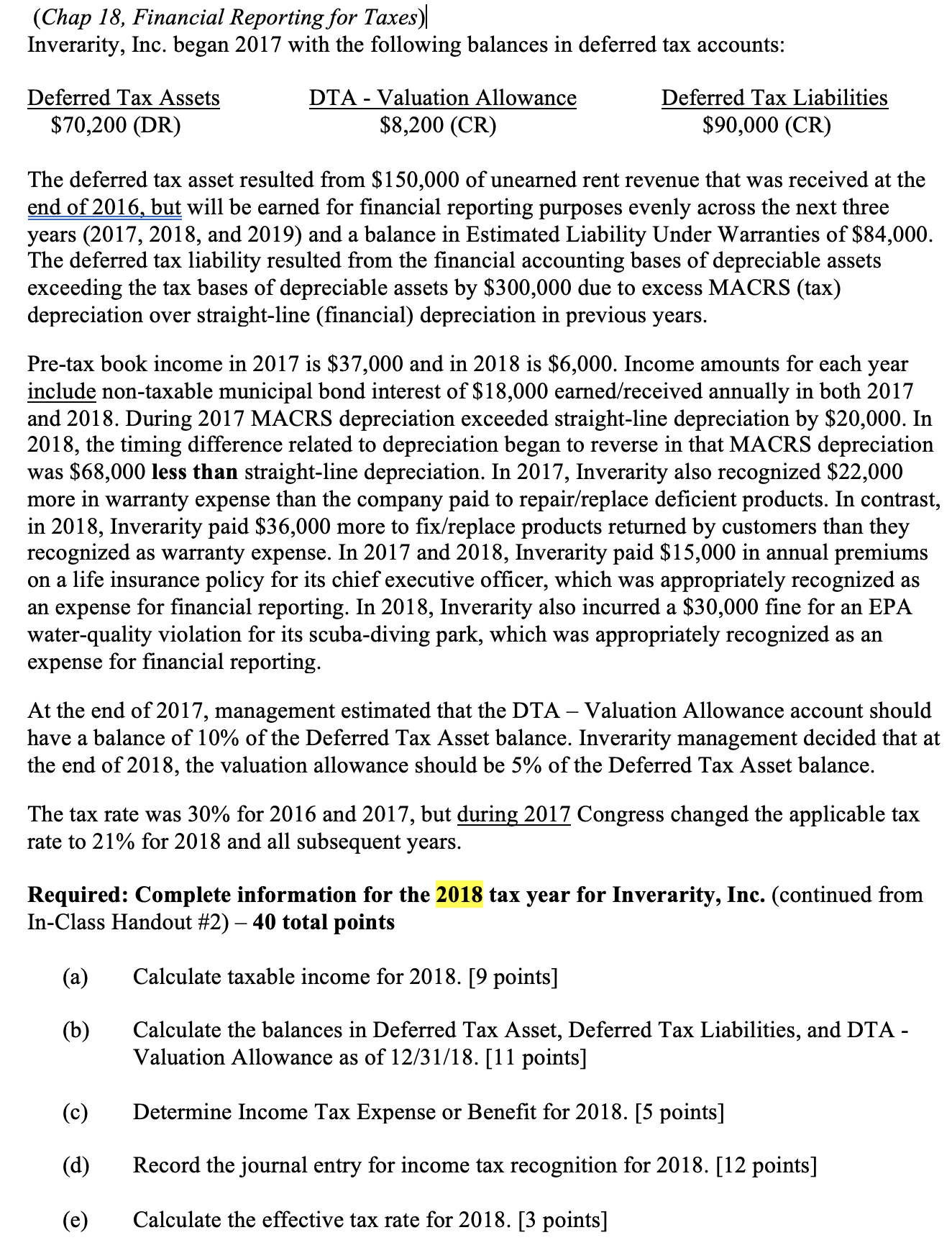(Chap 18, Financial Reporting for Taxes)| Inverarity, Inc. began 2017 with the following balances in deferred tax accounts: Deferred Tax Assets $70,200 (DR) DTA

(Chap 18, Financial Reporting for Taxes)| Inverarity, Inc. began 2017 with the following balances in deferred tax accounts: Deferred Tax Assets $70,200 (DR) DTA - Valuation Allowance $8,200 (CR) Deferred Tax Liabilities $90,000 (CR) The deferred tax asset resulted from $150,000 of unearned rent revenue that was received at the end of 2016, but will be earned for financial reporting purposes evenly across the next three years (2017, 2018, and 2019) and a balance in Estimated Liability Under Warranties of $84,000. The deferred tax liability resulted from the financial accounting bases of depreciable assets exceeding the tax bases of depreciable assets by $300,000 due to excess MACRS (tax) depreciation over straight-line (financial) depreciation in previous years. Pre-tax book income in 2017 is $37,000 and in 2018 is $6,000. Income amounts for each year include non-taxable municipal bond interest of $18,000 earned/received annually in both 2017 and 2018. During 2017 MACRS depreciation exceeded straight-line depreciation by $20,000. In 2018, the timing difference related to depreciation began to reverse in that MACRS depreciation was $68,000 less than straight-line depreciation. In 2017, Inverarity also recognized $22,000 more in warranty expense than the company paid to repair/replace deficient products. In contrast, in 2018, Inverarity paid $36,000 more to fix/replace products returned by customers than they recognized as warranty expense. In 2017 and 2018, Inverarity paid $15,000 in annual premiums on a life insurance policy for its chief executive officer, which was appropriately recognized as an expense for financial reporting. In 2018, Inverarity also incurred a $30,000 fine for an EPA water-quality violation for its scuba-diving park, which was appropriately recognized as an expense for financial reporting. At the end of 2017, management estimated that the DTA - Valuation Allowance account should have a balance of 10% of the Deferred Tax Asset balance. Inverarity management decided that at the end of 2018, the valuation allowance should be 5% of the Deferred Tax Asset balance. The tax rate was 30% for 2016 and 2017, but during 2017 Congress changed the applicable tax rate to 21% for 2018 and all subsequent years. Required: Complete information for the 2018 tax year for Inverarity, Inc. (continued from In-Class Handout #2) - 40 total points (a) Calculate taxable income for 2018. [9 points] (b) Calculate the balances in Deferred Tax Asset, Deferred Tax Liabilities, and DTA - Valuation Allowance as of 12/31/18. [11 points] (c) Determine Income Tax Expense or Benefit for 2018. [5 points] (d) Record the journal entry for income tax recognition for 2018. [12 points] (e) Calculate the effective tax rate for 2018. [3 points]
Step by Step Solution
There are 3 Steps involved in it
Step: 1

See step-by-step solutions with expert insights and AI powered tools for academic success
Step: 2

Step: 3

Ace Your Homework with AI
Get the answers you need in no time with our AI-driven, step-by-step assistance
Get Started


